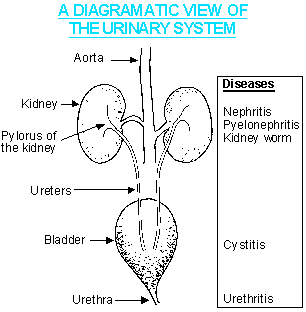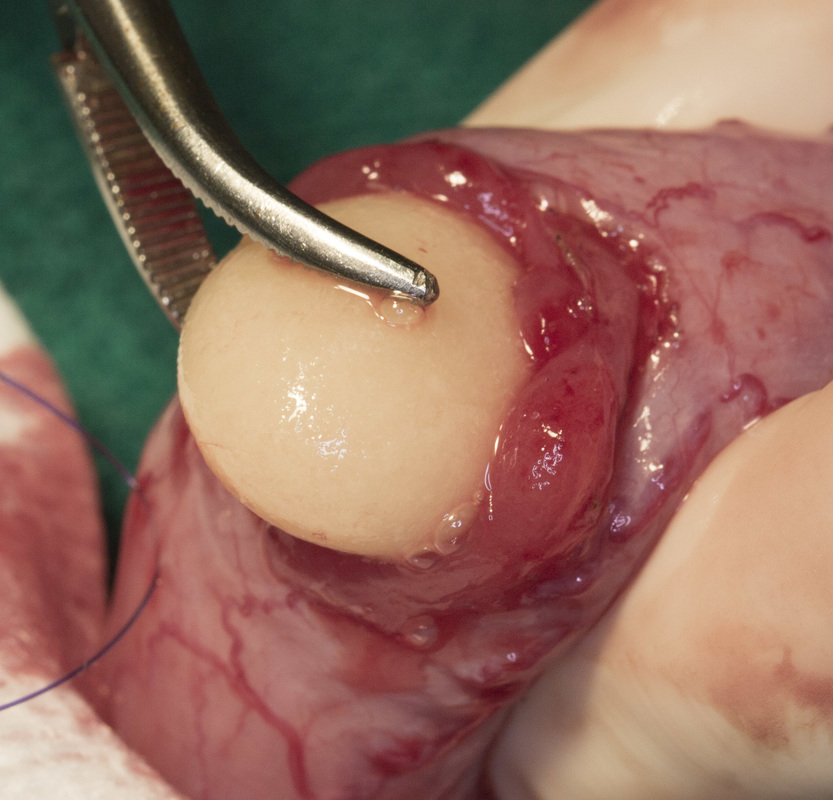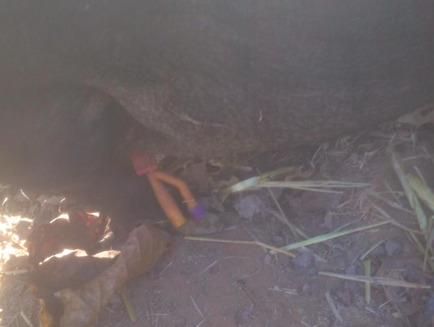Urinary issues commonly seen in mini pigs
Pigs have organs similar to humans, kidneys and a bladder. The kidneys are the organs in the body that filter out toxic and other waste materials from the bloodstream and maintain the body's fluid balance. Blood passes from the aorta into the kidney where it is filtered and returned back into the blood stream. The toxic products are then passed with fluid into the ureters which lead down to the bladder. Urine leaves the bladder via the urethra to the exterior. Any one of the factors below can cause serious issues with your pigs ability to excrete urine. If your pig is straining to urinate, that is an emergency and should be treated as such.
Terminology
Calculi - These may be seen as powder like deposits on the vulva of sow or as small stones in the urine. They are due to the crystallisation of mineral deposits and are not usually of any clinical significance. They are particularly striking in the kidneys of piglets which have died of TGE or greasy pig disease and are exaggerated in mercury poisoning.
Cystitis - Inflammation usually due to infection of the lining of the bladder. The normal thickness of the bladder is approximately 10mm but in severe cases it may be up to 50mm. Haemorrhage often occurs and in such cases mortality in sows can be high.
Hematuria - Blood in urine. Always consider this as serious, a sign of severe cystitis/pyelonephritis.
Hemoglobinuria - Free haemoglobulin in the urine.
Nephritis - Inflammation of the kidney. It can be associated with several different bacteria that are transmitted either via the bloodstream (septicaemia) or reflux from the bladder. Bacteria or their toxins can damage the delicate filtering mechanism of the kidney. These include Staphylococcus hyicus (greasy pig disease), salmonella, streptococci and erysipelas. Actinobaculum suis (formally known as Eubacterium suis or Corynebacterium suis) is the commonest specific cause of ascending (i.e. reflux) nephritis and cystitis. Hemorrhage into the kidneys is common in the swine fevers. Fungal mycotoxins may also damage the kidneys but do not cause inflammation.
pH - Urine is normally slightly acid, pH5 to 6.6. (Neutral is pH7). After weaning however, urine becomes alkaline (>pH7) for up to 3 weeks. Sows with pH more than 7.5 probably have pyelonephritis and mortality in such animals can be high particularly if it reaches a level of 8.
Proteinuria - Protein in the urine. Normal levels are 6-20mg/100 ml. Levels are elevated in kidney disease.
Pyelonephritis - The ureters arise from the cup-shaped pylorus or collecting area in the kidneys. Infection of this area together with the kidney is called pyelonephritis. It is a common disease in the sow. Bacteria associated with this include E. coli, streptococci and Actinobaculum suis the latter being the most common and important.
Pyuria - Pus in the urine.
Urethritis - Inflammation of the urethra.
Source:
http://www.thepigsite.com/pighealth/urinary-system/
Terminology
Calculi - These may be seen as powder like deposits on the vulva of sow or as small stones in the urine. They are due to the crystallisation of mineral deposits and are not usually of any clinical significance. They are particularly striking in the kidneys of piglets which have died of TGE or greasy pig disease and are exaggerated in mercury poisoning.
Cystitis - Inflammation usually due to infection of the lining of the bladder. The normal thickness of the bladder is approximately 10mm but in severe cases it may be up to 50mm. Haemorrhage often occurs and in such cases mortality in sows can be high.
Hematuria - Blood in urine. Always consider this as serious, a sign of severe cystitis/pyelonephritis.
Hemoglobinuria - Free haemoglobulin in the urine.
Nephritis - Inflammation of the kidney. It can be associated with several different bacteria that are transmitted either via the bloodstream (septicaemia) or reflux from the bladder. Bacteria or their toxins can damage the delicate filtering mechanism of the kidney. These include Staphylococcus hyicus (greasy pig disease), salmonella, streptococci and erysipelas. Actinobaculum suis (formally known as Eubacterium suis or Corynebacterium suis) is the commonest specific cause of ascending (i.e. reflux) nephritis and cystitis. Hemorrhage into the kidneys is common in the swine fevers. Fungal mycotoxins may also damage the kidneys but do not cause inflammation.
pH - Urine is normally slightly acid, pH5 to 6.6. (Neutral is pH7). After weaning however, urine becomes alkaline (>pH7) for up to 3 weeks. Sows with pH more than 7.5 probably have pyelonephritis and mortality in such animals can be high particularly if it reaches a level of 8.
Proteinuria - Protein in the urine. Normal levels are 6-20mg/100 ml. Levels are elevated in kidney disease.
Pyelonephritis - The ureters arise from the cup-shaped pylorus or collecting area in the kidneys. Infection of this area together with the kidney is called pyelonephritis. It is a common disease in the sow. Bacteria associated with this include E. coli, streptococci and Actinobaculum suis the latter being the most common and important.
Pyuria - Pus in the urine.
Urethritis - Inflammation of the urethra.
Source:
http://www.thepigsite.com/pighealth/urinary-system/
Should I give my pig hay?
Its been said that rich hay, such as Alfalfa, can cause stones. When pigs develop an interruption in the urinary habits, this can lead to even further complications like bladder rupture or sludge to build up in the bladder requiring surgery to correct. Alfalfa has been known to cause complications with the urinary system, it has the right combination of protein, calcium, phosphorus to predispose for the formation of crystals in the urine. Alfalfa is great for animals that are hard keepers or need to gain weight. It can also mess with calcium/phosphorus ratios which should be carefully calibrated in her feed. They sell Timothy hay for bunnies in bags at pet stores which is a better option for pigs. Timothy and grass hay is best to munch on, but not gain weight.
Per Cathy Zolicani, DVM
Avoid alfalfa hay - It has a high protein content and large amount of calcium - it may lead to urinary tract infections, bladder stones and obesity. Any type of grass hay (timothy, orchard, mixed) should be ok.
Per Cathy Zolicani, DVM
Avoid alfalfa hay - It has a high protein content and large amount of calcium - it may lead to urinary tract infections, bladder stones and obesity. Any type of grass hay (timothy, orchard, mixed) should be ok.
Urethral Obstructions
Urethral obstruction:
Predisposing causes include unregulated concentrate feeding, insufficient water or water supply high in calcium carbonate, neoplasia and urethral polyps. Clinical signs include inappetence, lethargy, dysuria, dribbling, straining and abdominal “pumping”. Some pigs may show no signs relating to urinary obstruction. Diagnosis is made on abdominal ultrasound. The bladder may be severely distended and may contain several liters of urine. Pyelonephritis and hydronephrosis may be complications in chronic cases. Retrograde catheterization is difficult and usually unsuccessful in relieving the urethral obstruction. Radiographs may be helpful in determining the possible cause and prognosis. A tube cystostomy is usually performed under general anesthesia following which a cysto-urethrogram can be done by injecting contrast through the cystostomy tube. However large volumes may be required and it is very difficult to get the contrast to fill the urethra beyond the urethral diverticulum.
Once a seal has formed between the bladder and abdominal walls (3 days post surgery) acidification of the urine is carried out by injecting a 30-50 ml of a commercial acidifying solution (Renacidin) into the bladder through the foley catheter. The tube is then clamped off for 30-60 minutes. This procedure is repeated for several days. Large calcium carbonate stones lodged in the distal urethra are unlikely to be dissolved. Once urethral patency is reestablished the tube is removed. This should not be done before 10 days after surgery. Complications include cystitis, tube obstruction or the tube may become dislodged and fall out. It is often possible to place a new tube through the same tract.
Other treatment options include normograde or retrograde intra-urethral lithotripsy; bladder marsupialization or prepubic urethrostomy for permanent urinary diversion.
~Dr. Van Amstel, DVM, UT
Predisposing causes include unregulated concentrate feeding, insufficient water or water supply high in calcium carbonate, neoplasia and urethral polyps. Clinical signs include inappetence, lethargy, dysuria, dribbling, straining and abdominal “pumping”. Some pigs may show no signs relating to urinary obstruction. Diagnosis is made on abdominal ultrasound. The bladder may be severely distended and may contain several liters of urine. Pyelonephritis and hydronephrosis may be complications in chronic cases. Retrograde catheterization is difficult and usually unsuccessful in relieving the urethral obstruction. Radiographs may be helpful in determining the possible cause and prognosis. A tube cystostomy is usually performed under general anesthesia following which a cysto-urethrogram can be done by injecting contrast through the cystostomy tube. However large volumes may be required and it is very difficult to get the contrast to fill the urethra beyond the urethral diverticulum.
Once a seal has formed between the bladder and abdominal walls (3 days post surgery) acidification of the urine is carried out by injecting a 30-50 ml of a commercial acidifying solution (Renacidin) into the bladder through the foley catheter. The tube is then clamped off for 30-60 minutes. This procedure is repeated for several days. Large calcium carbonate stones lodged in the distal urethra are unlikely to be dissolved. Once urethral patency is reestablished the tube is removed. This should not be done before 10 days after surgery. Complications include cystitis, tube obstruction or the tube may become dislodged and fall out. It is often possible to place a new tube through the same tract.
Other treatment options include normograde or retrograde intra-urethral lithotripsy; bladder marsupialization or prepubic urethrostomy for permanent urinary diversion.
~Dr. Van Amstel, DVM, UT
Dicolored Urine
Discolored urine?
This can be a result of your pig eating acorns, some medications or other foods can cause the color to change in the urine, but usually its indicative of some type of infection. Until you see the vet: increase water consumption by mixing 1/4 juice with 3/4 water. Bloody urine can be due to UTI or bladder stones or urethritis or something else. Try to collect a urine sample to take into the vet when you go if possible by using a soup ladle and placing under or behind your pig midstream, place the urine in a clean container. The fresher the urine, the more accurate the results will be. If he strains and cannot urinate, then it is an emergency and he should be seen right away. Click here to learn more about acorns and pigs.
I have also seen other pig parents complaining of blood in the urine and its been as a result of an injury to the penis or sheath. Be sure to check that area for any potential injuries as well.
This can be a result of your pig eating acorns, some medications or other foods can cause the color to change in the urine, but usually its indicative of some type of infection. Until you see the vet: increase water consumption by mixing 1/4 juice with 3/4 water. Bloody urine can be due to UTI or bladder stones or urethritis or something else. Try to collect a urine sample to take into the vet when you go if possible by using a soup ladle and placing under or behind your pig midstream, place the urine in a clean container. The fresher the urine, the more accurate the results will be. If he strains and cannot urinate, then it is an emergency and he should be seen right away. Click here to learn more about acorns and pigs.
I have also seen other pig parents complaining of blood in the urine and its been as a result of an injury to the penis or sheath. Be sure to check that area for any potential injuries as well.
Public service announcement from a pig rescue
Public Service Message
(From Lorelei Pulliam who has a pig rescue in northern Virginia)
One of their pigs was recently at the University of Tenn Vet Hospital with a blocked urethra. Because they got him there so quickly, (even though it is a 6.5 hour drive), he should recover. Most pigs suffer because their owners do not realize the gravity of the situation or it is misdiagnosed. This particular pig's bladder actually burst several years ago because a local vet misdiagnosed as constipation and sent home. His owner then abandoned him and left us with some very hefty bills.
Things every male pig owner should know:
- If you see your pig straining, you need to take immediate notice. It is often difficult to discern if they are trying to defecate or urinate. Some pigs will pump while standing there. They may still eat and drink.
- If no output, it is a red alert and they need immediate intervention.
- The surgery required will more than likely need to take place at a large vet hospital such as a University. Most local vets are not equipped to do so.
- A tube is placed into the bladder and out the abdomen for the urine to drain.
- The bladder will have a medication that breaks up stones flushed into it. This may take several days. They can also do a little roter rooter work in the urethra itself and look for stones and strictures.
- Once the urethra is open again, the tube is removed
- In the rare case that this does not work, a marsupialization can be performed with a permanent opening created for the bladder to drain. We had one elderly rescue live like this for several years after recurring blockages left no other option. He was 19 when it was done.
- Encourage your pigs to drink lots and pee often. One reason the stones form in the bladder is urine sitting too long. In my experience, it is usually house pigs that develop this condition.
- Recognize the symptoms, take quick action and know that there is treatment. It is a hard hard death if left unattended.
Routine urinalysis as part of an annual examination may enable early diagnosis and prevention of serious urinary tract disease in PBPs
(From Lorelei Pulliam who has a pig rescue in northern Virginia)
One of their pigs was recently at the University of Tenn Vet Hospital with a blocked urethra. Because they got him there so quickly, (even though it is a 6.5 hour drive), he should recover. Most pigs suffer because their owners do not realize the gravity of the situation or it is misdiagnosed. This particular pig's bladder actually burst several years ago because a local vet misdiagnosed as constipation and sent home. His owner then abandoned him and left us with some very hefty bills.
Things every male pig owner should know:
- If you see your pig straining, you need to take immediate notice. It is often difficult to discern if they are trying to defecate or urinate. Some pigs will pump while standing there. They may still eat and drink.
- If no output, it is a red alert and they need immediate intervention.
- The surgery required will more than likely need to take place at a large vet hospital such as a University. Most local vets are not equipped to do so.
- A tube is placed into the bladder and out the abdomen for the urine to drain.
- The bladder will have a medication that breaks up stones flushed into it. This may take several days. They can also do a little roter rooter work in the urethra itself and look for stones and strictures.
- Once the urethra is open again, the tube is removed
- In the rare case that this does not work, a marsupialization can be performed with a permanent opening created for the bladder to drain. We had one elderly rescue live like this for several years after recurring blockages left no other option. He was 19 when it was done.
- Encourage your pigs to drink lots and pee often. One reason the stones form in the bladder is urine sitting too long. In my experience, it is usually house pigs that develop this condition.
- Recognize the symptoms, take quick action and know that there is treatment. It is a hard hard death if left unattended.
Routine urinalysis as part of an annual examination may enable early diagnosis and prevention of serious urinary tract disease in PBPs
10/22/2015 update on Stinky
Stinky is home after 3 weeks in the hospital. He still has the cystotomy tube in him because his bladder never fully empties. His case is complex because a local vet misdiagnosed him the first time when he was owned by the person who dumped him here and his bladder burst. Now, the tube isn't draining much so we probably need to take him back. But he is happy and looking great. For which we are grateful.
Stinky is home after 3 weeks in the hospital. He still has the cystotomy tube in him because his bladder never fully empties. His case is complex because a local vet misdiagnosed him the first time when he was owned by the person who dumped him here and his bladder burst. Now, the tube isn't draining much so we probably need to take him back. But he is happy and looking great. For which we are grateful.
Prevention of urolithiasis in livestock (in general) by David C. Van Metre, DVM, DACVM downloadable file
| urolithiasis_prevention.doc |



